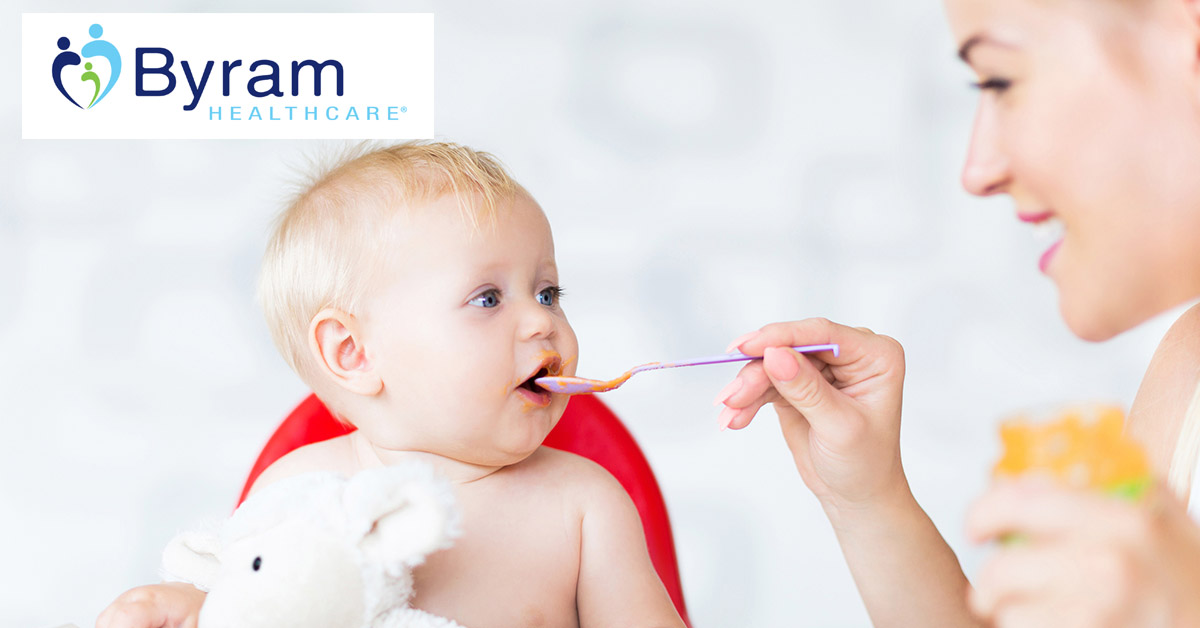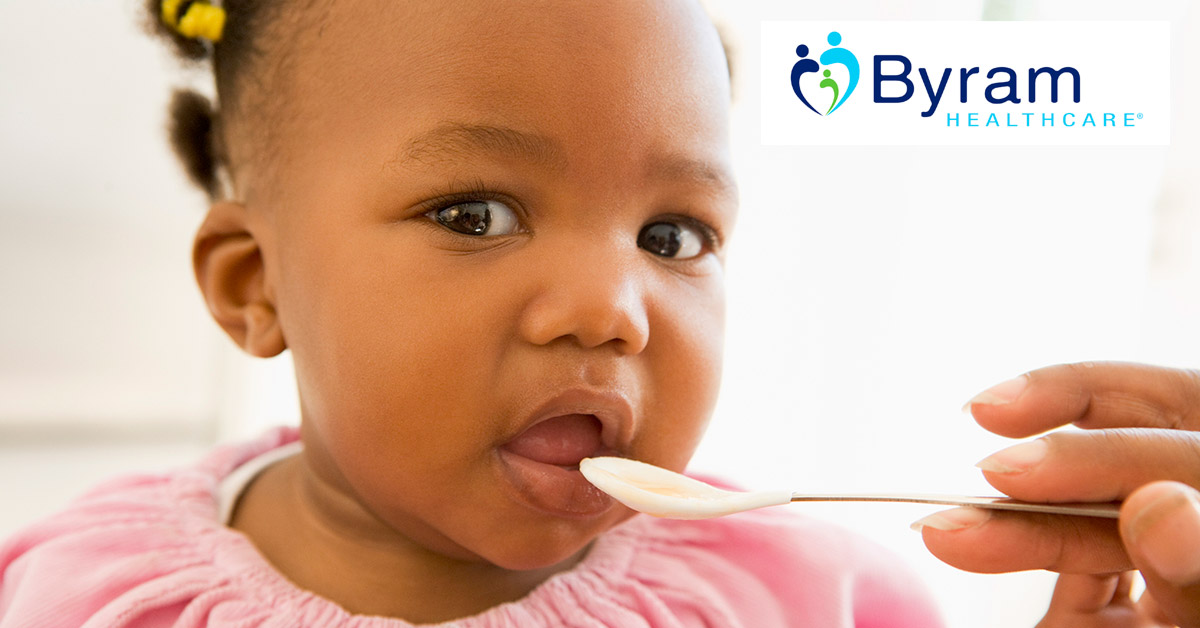Introducing Solid Foods – No More Breastfeeding?
Breastfeeding is a complicated subject. It is sometimes hard to start with latching and forming the initial connection and also hard to stop. However, as your baby grows, they will begin to transition into solid foods.
Does that mean you should stop breastfeeding? We’re here to give you the answers.
When to Introduce Solid Foods
One thing that a lot of mothers struggle with is when to first introduce solid foods. It is confusing and there is a lot of contradicting information spread over the Internet. However, the American Academy of Pediatrics (AAP) recommends that you should feed your baby breast milk exclusively for approximately the first 6 months of their lives1.
What does that mean?
It means that your baby does not need to eat anything else besides breast milk – no water, juice, solid foods or formula. But what does “approximately” mean in terms of age? It isn’t exactly a set-in-stone date. Luckily, there are many signs you should keep an eye out for that indicates your baby is ready.
Signs your baby is ready to start solids
There are many telltale signs that will indicate that your baby is ready to begin experimenting with solid foods. Many of these are guidelines from the American Academy of Pediatrics and can be found in this helpful book, “Nutrition: What Every Parent Needs to Know.”
1. Maintaining Head Control
One very important sign is that your baby is able to keep their heads in an upright position3. If they cannot do this, it is way too early to think about solids.
2. Supporting Themselves
When you begin to feed your baby solid foods, they need to be able to support themselves in a high chair, a feeding seat or an infant seat that allows strong head control2.
3. Loss of the Tongue Thrust Reflex
The tongue thrust reflex is a reflex that pushes food back out of the mouths of young babies4. It is known as a protective reflex, and indicates that your baby’s digestive system may not be ready for solids.
4. Weight Gain
Babies gain weight everyday, but once your baby doubles their birth weight; they are usually ready for solids. The typical guidelines suggest a minimum of 13lbs or more2.
5. Food Curiosity
Finally, your baby will begin unleashing a newfound curiosity for food. They may start to look at your food more frequently or even start to reach for it.
Why wait 6 months?
The reason that the AAP recommends waiting approximately 6 months is because your baby needs to be ready, both physically and mentally, to begin introducing solid foods. Breast milk is the most nutrient dense foods that your baby will get and helps aid in healthy development.
Alongside with developmental benefits, here are some other reasons you should wait5:
- Greater protection from illness
- More mature digestive system
- Lower risk of obesity1
- Stronger protection from anemia
- Easier transition
- More rapid postpartum weight loss5
Your Baby’s Needs
Introducing solid foods does not mean it’s time to stop breastfeeding! In fact, breast milk should be your baby’s primary source of nutrition for their first year7.
Breast milk is still the most important part of your baby’s diet. Until you begin to wean them off of breast milk, which usually occurs around 12 months, you need to continue nursing. That’s why we recommend giving your baby mostly breast milk, and supplementing with solid food snacks during the beginning of this transition.
As they get older, you will begin to switch this proportion. Once they get to be about 1 year old, they will be eating more solids and you can give them breast milk as a snack. Your pediatrician can help you figure this out, but usually at about 1 year, your baby only needs 24-30oz of liquid per day8.
Some warnings to be aware of
The main thing that you want to watch out for when introducing solid foods is allergies. Work on introducing one type of food at a time so that you are able to keep an eye out for any allergic reactions. If you notice any diarrhea, rashes or vomiting, stop feeding your baby that food and talk to your pediatrician6. If you notice any serious reactions that may indicate anaphylaxis, call 911 immediately.
Usually, foods such as veggies, fruits and meats don’t raise any concern for allergies, but always keep an eye out just in case3.
How Often to Feed
One thing that will be confusing is how much food you should give your baby and how often. The short answer is… it depends. Usually the deciding factor is age, weight gain and personal development. Each baby has different needs, but if you pay attention, you will start to understand their patterns.
Snacks vs. Meals
At first, your baby will only eat solid food once a day, but as they get older it will continue to increase. By around 6-7 months, two solid meals a day is normal and by 8-9 months it is likely that they will be eating solid food three times a day3.
Breastfeeding or solids, which comes first?
In the beginning, it doesn’t make too much of a difference. You can breastfeed first, and then try a bit of solid food, or vice versa. However, as your baby gets older, you should try and give them solid foods first. This is because if you breastfeed first, your baby may fill up on breast milk and be less interested in trying solid foods8. This will potentially lead to problems once you start to wean.
You can do this in small increments so that your baby still primarily gets breast milk, but this helps the introduction process go more smoothly.
Schedules and Times
Again, every baby is different, but it is always helpful to have some guidelines in place so you know you’re not doing something completely out of the ordinary. Check out a few sample schedules for 6-8 month olds as well as 8-12 month olds.
What Types of Food?
The next big question is, once it is time to start with solid foods, what types of food should you focus on and what types of food should you avoid?
Foods to Focus On

The foods you want to focus on at first will usually be single ingredient foods that don’t contain any added salt or sugar3. Some good first foods include:
- Purred vegetables or fruits
- Bananas
- Pears
- Carrots
- Sweet potatoes
- Squash
- Avocados
- Applesauce
- Single-grain cereals
- Small amounts of proteins such as:
- Poultry
- Tofu
- Meat
- Fish
A lot of mother’s fear that if they give their babies fruits before vegetables then they will be more likely to develop a strong dislike for vegetables. However, there is no evidence for this2. It is merely because babies have a preference for sweet tasting foods that they prefer fruits to vegetables. You can introduce either one first; it’s all up to you.
Foods to Avoid
There are a few foods that you want to make sure and avoid. This is primarily because of the choking risks involved as well as potential allergies. These include:
- Cow’s milk
- Wheat
- Corn
- Salt
- Sugar
- Highly processed foods
- Caffeine
- Chocolate
- Honey
- Grapes
- Popcorn
- Berries
- Peanut Butter
- Whole nuts or seeds
Changes to Expect After Starting Solids
When your baby begins to eat solid foods, you will notice a major change in their stools. They will start to turn varying colors2 (depending on the foods they eat) and will become more solid, but never fear… it’s normal!
If you find that your baby is a little constipated, you may be feeding them too many solids. Luckily, all you need to do is increase the amount of breast milk that you are giving them daily and the problem should go back to normal. If, however, it doesn’t, talk to your pediatrician.
When to Wean
It’s completely up to you to decide when to wean your baby. Most mothers begin the process at 12 months, but there are many who continue on for a year or two more.
If you continue to breastfeed after two years, we recommend giving them solid foods as their main source of nutrition and supplementing it with breast milk as a snack throughout the day7.
Conclusion
Don’t forget to enjoy this moment! It is a huge change and will be followed by many fun expressions and reactions as your baby’s palette begins to mature. If you have anything else to add, or want to share a fun story about your baby trying new foods, comment on our Facebook page!
In addition, thanks to the Affordable Care Act, expectant mothers are eligible to receive an electric breast pump covered by their insurance provider! Just head over to our page and browse our selection.
SOURCES:
1http://pediatrics.aappublications.org/content/129/3/e827.full
2https://healthychildren.org/English/ages-stages/baby/feeding-nutrition/Pages/Switching-To-Solid-Foods.aspx
3https://www.babycenter.com/0_introducing-solids_113.bc
4http://breastfeeding.support/starting-solid-foods/
5https://kellymom.com/ages/older-infant/delay-solids/
6https://www.webmd.com/parenting/baby/starting-solid-food
7https://www.breastfeeding-problems.com/introducing-solid-foods.html
8https://www.verywell.com/how-to-introduce-solid-foods-while-breastfeeding-431799






